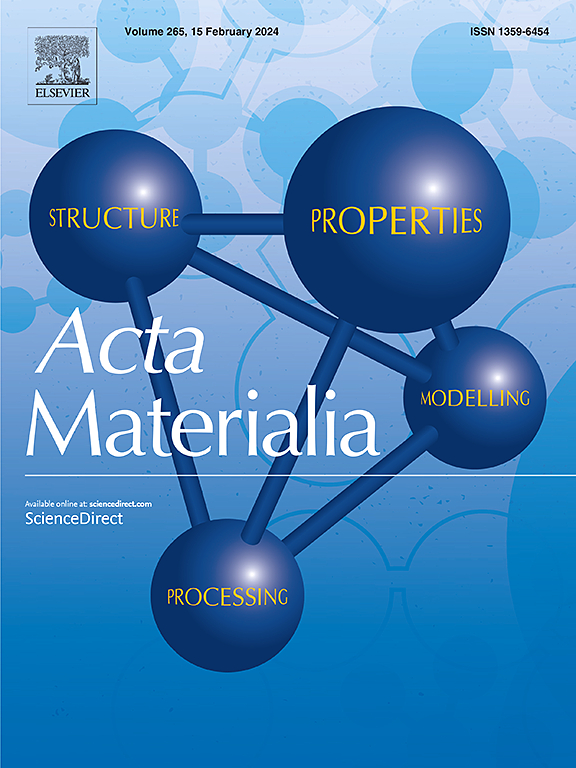基于神经网络的晶体塑性模型从中观到宏观的多尺度建模
IF 8.3
1区 材料科学
Q1 MATERIALS SCIENCE, MULTIDISCIPLINARY
引用次数: 0
摘要
多尺度模拟通过结合微观层面的物理变形演变,在宏观行为分析中发挥着关键作用,为材料科学和工业制造提供了有价值的见解。然而,由于平衡效率和准确性的挑战,尽管其概念由来已久,但其发展仍然相对滞后。为了解决这一问题,目前的研究引入了一种基于循环神经网络的本构模型作为晶体塑性的中尺度代理,称为多晶线性化最小状态单元(PolyLMSC),它由两个平行的LMSCs组成,可以同时预测力学响应和织构演变。基于广义球调和函数的傅里叶系数,提出了一种基于广义球调和函数傅里叶系数的纹理-力学连接方法,该方法利用傅里叶空间的线性性促进了PolyLMSC模型向不同纹理的扩展。为了提高在任意加载条件下的泛化性,采用增量尺寸和加载方向随机变化的任意应变路径进行数据生成。在单材料点的验证过程中,PolyLMSC模型在任意载荷下对不同纹理具有良好的泛化性能。此外,PolyLMSC模型通过各种组件尺度的模拟案例进行了评估,表明在中观和宏观尺度预测上具有合理的准确性,与传统晶体塑性模型相比,计算效率提高了1 ~ 2个数量级。验证结果表明,所提出的模型是有效和准确的多尺度模拟的候选者,连接了中尺度和宏观尺度。本文章由计算机程序翻译,如有差异,请以英文原文为准。


Multiscale modelling with neural network-based crystal plasticity model from meso‑ to macroscale
Multiscale simulation plays a pivotal role in macroscopic behavior analysis by incorporating micro-level physical deformation evolutions, which provides valuable insights for materials science and industrial manufacturing. However, its development has remained relatively retarded despite the long-established concept due to the challenge of balancing efficiency and accuracy. To address this issue, the current study introduces a recurrent neural network-based constitutive model as the mesoscale surrogate for crystal plasticity, termed Polycrystalline Linearized Minimal State Cells (PolyLMSC), which comprises two parallel LMSCs to predict both the mechanical response and texture evolution simultaneously. A new texture-mechanics linkage method is proposed based on the Fourier coefficients of generalized spherical harmonic (GSH) functions, where the linearity of Fourier space promotes the PolyLMSC model to extend to different textures. To enhance generalizability across arbitrary loading conditions, arbitrary strain paths with random and diverse variations in incremental size and loading direction are adopted for data generation. During the validation at the single material point, the PolyLMSC model shows good generalization performance across different textures under arbitrary loading. Furthermore, the PolyLMSC model is evaluated through various component-scale simulation cases, illustrating reasonable accuracy at meso‑ and macroscale predictions with 1∼2 orders of magnitude improvement in computational efficiency compared to conventional crystal plasticity models. The validation results demonstrate the proposed model as a promising candidate for efficient and accurate multiscale simulations, bridging the meso‑ to macroscales.
求助全文
通过发布文献求助,成功后即可免费获取论文全文。
去求助
来源期刊

Acta Materialia
工程技术-材料科学:综合
CiteScore
16.10
自引率
8.50%
发文量
801
审稿时长
53 days
期刊介绍:
Acta Materialia serves as a platform for publishing full-length, original papers and commissioned overviews that contribute to a profound understanding of the correlation between the processing, structure, and properties of inorganic materials. The journal seeks papers with high impact potential or those that significantly propel the field forward. The scope includes the atomic and molecular arrangements, chemical and electronic structures, and microstructure of materials, focusing on their mechanical or functional behavior across all length scales, including nanostructures.
 求助内容:
求助内容: 应助结果提醒方式:
应助结果提醒方式:


